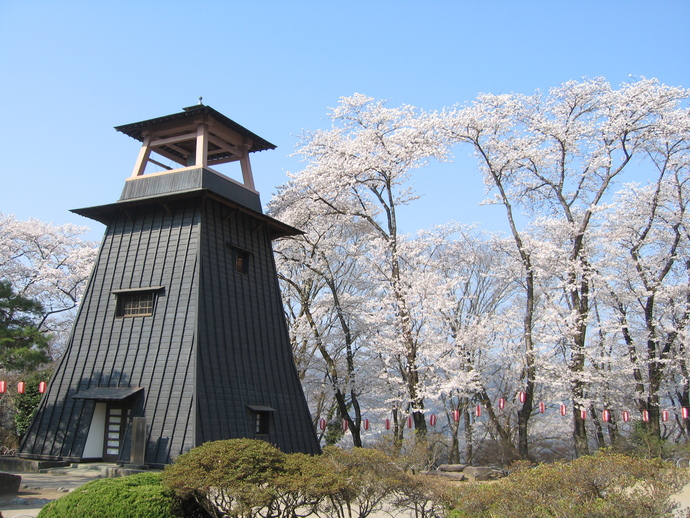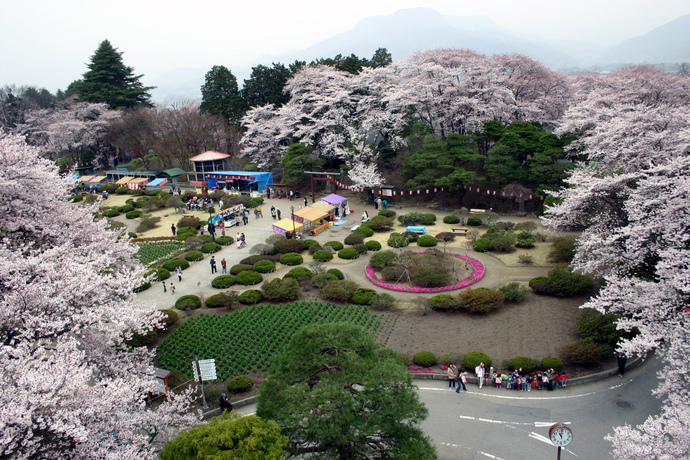Numata Park and Castle Site

Numata Park and Castle Site
Numata Park is a large, hilly green space overlooking the Usune and Tone Rivers. The park grounds include the site of Numata Castle, a sixteenth-century fortress that was converted into the administrative center of the Numata domain during the Edo period (1603–1867). Only isolated parts of the castle’s fortifications remain. The park is popular for the wide variety of flowers that bloom between April and October, for its views over the Tone River valley toward Mt. Hotaka and the Tanigawa mountain range, and for historical structures such as the Ubukata House, a seventeenth-century merchant’s house relocated from the center of town and now open to the public as a museum.
A short-lived stronghold
The first structures on the site that would become Numata Park were built by the Numata family, which controlled the area around the present-day city of Numata for several centuries until the late 1500s. In 1532, the family established a fortress high above the two rivers, a strategic location but one that had remained largely uninhabited due to a lack of fresh water. This stronghold functioned as a lookout from which the Numata family could keep an eye on traffic on the nearby rivers as well as monitor the roads north over the mountains to Echigo Province (present-day Niigata Prefecture) and Aizu (in today’s Fukushima Prefecture).
Several families vied for control of Numata in the late 1500s. The area was eventually seized by the Sanada family, who initiated a number of extensive construction projects to develop their domain under the leadership of Sanada Nobuyuki (1566–1658). The family had canals dug to bring fresh water to the highland, which made it possible to establish a town there. In 1597, the Sanada family finished building a large castle on the site of the Numata family’s modest fortress, incorporating two moats, stone walls, gates, several watchtowers, and a five-story keep. Samurai residences were built between the castle and the rest of the town, which was expanded to the east and south.
However, the grand Numata Castle was demolished in 1682 after the ruling Tokugawa shogunate dispossessed the Sanada family for misgovernance. Afterwards, the Numata domain was governed by many different daimyo and eventually passed into the hands of the Toki family. They built a residence in the outskirts of the castle, but did not rebuild the fortifications because their tenure was during a time of peace.
From fort to park
The Toki family governed Numata until the Meiji Restoration in 1868, which put an end to the long period of warrior rule. The family moved to Tokyo and their residence was abandoned, and the site of the former castle remained unused until 1916. It was purchased by Kume Taminosuke (1861–1931), a wealthy Numata-born businessman whose family had served the Toki family prior to the Meiji Restoration. Kume had the grounds turned into a park, which he donated to the local government in 1926.
Due to the turbulent history of the site, very little of the sixteenth-century castle remains in the park today. Among the surviving structures are a short section of the inner moat, some ramparts, and the foundations of the westernmost watchtower. Instead of a lookout, this stone base now supports a 400-year-old cherry tree whose blooms are said to mark the arrival of spring in Numata. A reproduction of the Numata Castle bell hangs in the park’s belfry and is rung at six o’clock every morning and evening. The original, cast in 1634, is on display at the Numata City History Museum.


ご意見をお聞かせください
このページに関するお問い合わせ
Cultural Properties Protection Department
888 Shimonocho,Numata-shi, Gumma-ken 378-8501
Please use the dedicated form for inquiries






